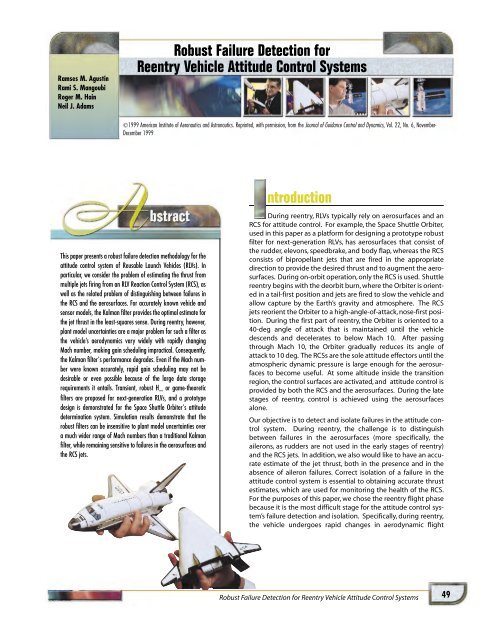2000 - Draper Laboratory
2000 - Draper Laboratory
2000 - Draper Laboratory
- No tags were found...
Create successful ePaper yourself
Turn your PDF publications into a flip-book with our unique Google optimized e-Paper software.
Ramses M. AgustinRami S. MangoubiRoger M. HainNeil J. AdamsRobust Failure Detection forReentry Vehicle Attitude Control Systems©1999 American Institute of Aeronautics and Astronautics. Reprinted, with permission, from the Journal of Guidance Control and Dynamics, Vol. 22, No. 6, November-December 1999This paper presents a robust failure detection methodology for theattitude control system of Reusable Launch Vehicles (RLVs). Inparticular, we consider the problem of estimating the thrust frommultiple jets firing from an RLV Reaction Control System (RCS), aswell as the related problem of distinguishing between failures inthe RCS and the aerosurfaces. For accurately known vehicle andsensor models, the Kalman filter provides the optimal estimate forthe jet thrust in the least-squares sense. During reentry, however,plant model uncertainties are a major problem for such a filter asthe vehicle’s aerodynamics vary widely with rapidly changingMach number, making gain scheduling impractical. Consequently,the Kalman filter's performance degrades. Even if the Mach numberwere known accurately, rapid gain scheduling may not bedesirable or even possible because of the large data storagerequirements it entails. Transient, robust H ∞ or game-theoreticfilters are proposed for next-generation RLVs, and a prototypedesign is demonstrated for the Space Shuttle Orbiter's attitudedetermination system. Simulation results demonstrate that therobust filters can be insensitive to plant model uncertainties overa much wider range of Mach numbers than a traditional Kalmanfilter, while remaining sensitive to failures in the aerosurfaces andthe RCS jets.ntroductionDuring reentry, RLVs typically rely on aerosurfaces and anRCS for attitude control. For example, the Space Shuttle Orbiter,used in this paper as a platform for designing a prototype robustfilter for next-generation RLVs, has aerosurfaces that consist ofthe rudder, elevons, speedbrake, and body flap, whereas the RCSconsists of bipropellant jets that are fired in the appropriatedirection to provide the desired thrust and to augment the aerosurfaces.During on-orbit operation, only the RCS is used. Shuttlereentry begins with the deorbit burn, where the Orbiter is orientedin a tail-first position and jets are fired to slow the vehicle andallow capture by the Earth’s gravity and atmosphere. The RCSjets reorient the Orbiter to a high-angle-of-attack, nose-first position.During the first part of reentry, the Orbiter is oriented to a40-deg angle of attack that is maintained until the vehicledescends and decelerates to below Mach 10. After passingthrough Mach 10, the Orbiter gradually reduces its angle ofattack to 10 deg. The RCSs are the sole attitude effectors until theatmospheric dynamic pressure is large enough for the aerosurfacesto become useful. At some altitude inside the transitionregion, the control surfaces are activated, and attitude control isprovided by both the RCS and the aerosurfaces. During the latestages of reentry, control is achieved using the aerosurfacesalone.Our objective is to detect and isolate failures in the attitude controlsystem. During reentry, the challenge is to distinguishbetween failures in the aerosurfaces (more specifically, theailerons, as rudders are not used in the early stages of reentry)and the RCS jets. In addition, we also would like to have an accurateestimate of the jet thrust, both in the presence and in theabsence of aileron failures. Correct isolation of a failure in theattitude control system is essential to obtaining accurate thrustestimates, which are used for monitoring the health of the RCS.For the purposes of this paper, we chose the reentry flight phasebecause it is the most difficult stage for the attitude control system’sfailure detection and isolation. Specifically, during reentry,the vehicle undergoes rapid changes in aerodynamic flightRobust Failure Detection for Reentry Vehicle Attitude Control Systems 49
















